Is it possible to add salt to a humidifier: subtleties of water preparation and existing prohibitions
A comfortable indoor humidity level is 40-60%.When the number drops below the minimum level, the mucous membranes in the mouth and nose dry out, and various ailments appear. Devices that saturate the air with moisture come to the rescue. Modern models can additionally clean the air from dust, allergens, and fill it with aromas.
But if it is permissible add oil to humidifier air, can salt be added? The benefits of sea and simply salt air have been proven and obvious. On the seashore it forms naturally: in the form of an aerosol, when the wind blows foam off the surf waves. Salt dust hovers in salt caves, which we breathe. But is it possible to experiment with a humidifier to create a similar indoor microclimate?
In this article we will analyze this issue in detail - we will talk about whether it is permissible to add salt to a household humidifier and which models are capable of evaporating water with additives. We also focus on whether it is advisable to use a humidifier as an inhaler. We will provide the presented material with thematic photos and useful video recommendations.
The content of the article:
Adding salt to different types of humidifiers
At humidifier operation you need to follow the instructions for the specific model. Only this document describes in detail the purpose of the device and what is strictly prohibited to do while using it.
Studying recommendations for the operation of devices of different types from different manufacturers gives an understanding of the general rules. These tips can be generalized and applied to the use of specific types of humidifiers.
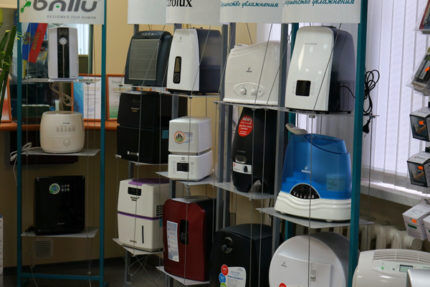
The instructions for devices often contain clear instructions to fill the tank with purified water due to the sensitivity of the parts to various impurities. But some humidifier designs still allow the use of oils and salt.
Many modern models have a special capsule designed for aromatic mixtures. Loading salt into it does not always lead to the desired effect, but it also does not damage the elements of the device.
Features of traditional devices
Eco-friendly, safe, simple in design devices. The principle of their operation is based on the natural evaporation of water.

Traditional humidifiers are universal and suitable for any room. The only negative is the high cost.
These devices are not so sensitive to the quality of the water being poured. But manufacturers categorically do not recommend adding salt to the tank, from where it will evaporate and be distributed by a fan throughout the room.

Dissolving regular or sea salt or flavorings in water will damage the parts of the air humidifier and cause cracks, leaks.
The result of neglecting these requirements will be damage to the components of the unit, the release of whitish particles into the air, and their settling on furniture and interior items.
The nuances of using steam devices
Water is poured into the steam humidifier and heated to boiling temperature. The principle of operation of the device is similar to an electric kettle.
Intensive evaporation leads to a sharp increase in the level of humidity and temperature in the room. Therefore, the device is equipped with a special sensor - a hygrostat, which monitors the permissible limits and turns off the steam generator if they are exceeded.
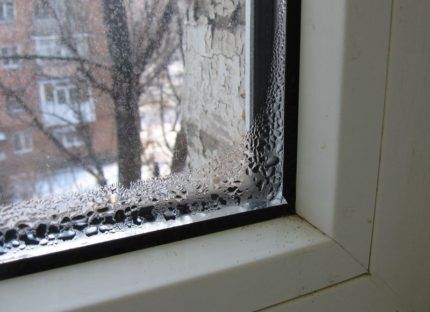
The steam device should not be left unattended in rooms where there are children, but it can be used for aromatizing the air or inhalation, unless there is a direct prohibition in the instructions. The advisability of carrying out medical procedures using a humidifier will be discussed below.
Most manufacturers recommend filling the water container only with clean water. Mineral water is also officially banned. And a carbonated liquid when heated in a closed tank can even lead to a mini-explosion.
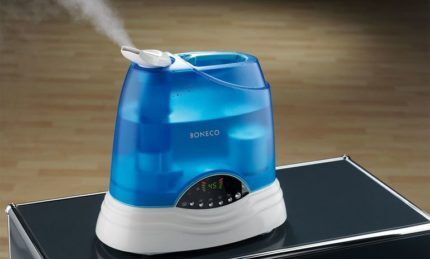
Limitations may be related to the design features of the device. In some models it is difficult clear the internal elements of the device from oils, salt and other deposits.
The presence of impurities in the water can impair the performance of the steam humidifier and cause breakdown of expensive equipment.
Operation of ultrasonic units
In these devices, water from a special container falls onto an ultrasonic membrane, where, under the influence of high frequencies, drops are broken into microelements.
The particles are then distributed throughout the room by natural or forced air currents.
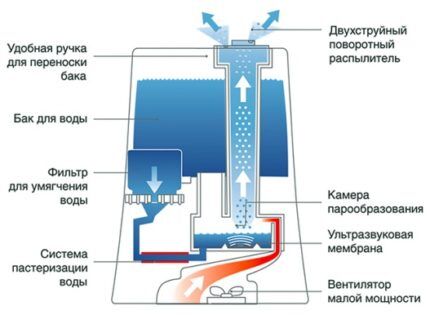
But if the ultrasonic humidifier is not initially equipped with additional filters, this makes it sensitive to the quality of the water used. All contaminants from unfiltered liquid will settle on the main filter and lead to device breakdown.
The operating principle of the device promotes the sedimentation of all impurities on surrounding objects. When crushing substances from water, the membrane vibrates and turns the particles into a water suspension, so it is advisable not to use additives.

Even a pinch of salt can damage the appliance and damage household items. The manufacturer is not responsible for such experiments; warranty repairs in such cases are paid by the user in full.
We have provided more recommendations for using an ultrasonic humidifier in this material.
The nuances of preparing water for a tank
The rule applies to absolutely all models of humidifiers: the better the quality of the water, the longer and better the device will work.
Steamers can be filled with tap water, but filtered.If it is not cleaned first, sediment will form, which will negatively affect the operation of the device.

The most demanding are ultrasonic. They need reverse osmosis filtered or distilled water. The exception is more expensive devices with several replaceable filters. We talked about making distilled water at home in this material.
Water hardness also matters. When excessively hard water flows from the tap, it is more convenient to purchase a steam or traditional device.
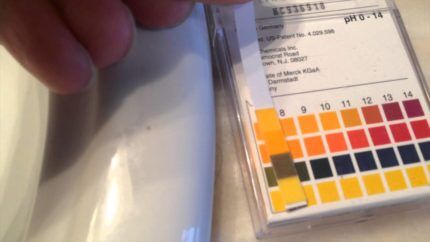
If you like an ultrasonic model, the manufacturer of which recommends filling the tank only with distilled water, it is inexpensive and is sold at the nearest auto store.
Comparison of a vaporizer with an inhaler
Many users are confident that they can use a humidifier for therapeutic inhalations. But is it really that effective?
The humidifier creates intense steam and irrigates the room with micro-drops of water. Inhalers work on a similar principle, into which you can add saline or salt.
But the task of the inhaler is to transport medications deep into the respiratory tract, so you can’t put it with a humidifier at the same time.
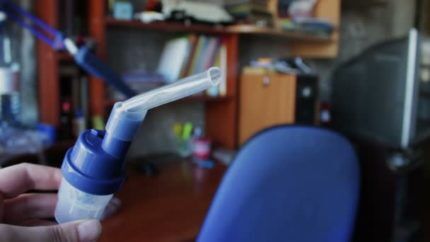
Manufacturers of inhalers calculate the dispersion of particles and the speed of their movement.To reach the desired parts of the respiratory tract, drugs must take on a certain form.
The design and principle of operation of inhalers differs from humidifiers, so medications, oils and saline solutions can be added to the former.
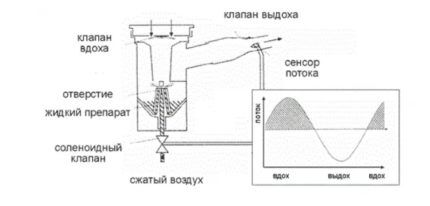
In addition, the chemical composition of the water in the humidifier changes and its use as an inhaler turns out to be useless. But the first device saturates the air in the room with moisture and can be used both for prevention and in complex therapy in the treatment of nasopharyngeal diseases.
In combination with an inhaler, a humidifier significantly facilitates the process of getting rid of ailments associated with drying out mucous membranes or the appearance of bacteria and viruses on them.
Conclusions and useful video on the topic
Analysis of humidity indicators in different conditions. Demonstration of the device and operating principle of different types of humidifiers:
Causes of humidifier failures. What happens to the board when permanent condensation appears:
The example of an aquarium test shows how to determine water hardness.
Basics purpose of the humidifier - increase air humidity. It can also perform additional functions, but this will definitely be indicated in the characteristics of the device.
To avoid problems with the device, you must adhere to the manufacturer’s clear recommendations for the selected model. If the instructions say “use only clean water,” that’s what you should do. If there are no direct prohibitions on the use of additives or the design contains a capsule, you can experiment with salt.
What type of humidifier do you have? Do you add salt to it? Tell us about your experience using the device - the feedback block is located below. If you still have questions or want to clarify a number of points that we did not cover in this material, ask them to our experts and other visitors to our site.



